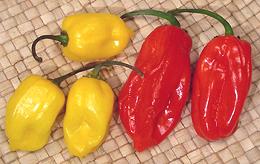 In West Africa, Chilis are commonly called "Peppers", which causes
considerable confusion. There are various other "Peppers" in the region,
some of which are related to Black Pepper and others are not - but none
are at all related to Chilis.
In West Africa, Chilis are commonly called "Peppers", which causes
considerable confusion. There are various other "Peppers" in the region,
some of which are related to Black Pepper and others are not - but none
are at all related to Chilis.
All the Chilis of Africa came from Mexico, Central America, South America, and the Caribbean. The nearest relative to the Chilis indigenous to Africa is the Eggplant.
More on Chili Peppers.
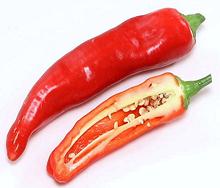 [C. annuum]
[C. annuum]
This is the favorite chili for making the famous Harissa Sauce of
Tunisia, which has spread to the rest of the Maghreb region. It was
probably developed from chilis brought by the Spanish during their
occupation of Tunisia between 1535 and 1574. The larger in the photo
was 4.2 inches long and 1.1 inches diameter, with hotness about
H3. The flesh is sweet and thin
enough to dry well.
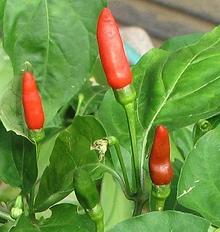
[Piri Piri, (Portugal, Africa); Ata Wewe (Yoruba - Nigeria); (C. frutescens]
Up to 2 inches long, these are standard Bird Chilis, brought to Africa
by the Portuguese, and are used under the same name in Portugal as well.
They are quite hot (H9). They are not
marketed to any extent in North America, so you must grow your own or
use a substitute. Subst:
Thai Chilis are not as hot but much more
available in North America.
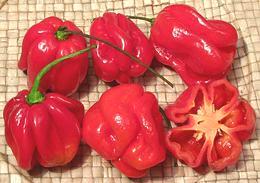 [C. frutescens]
[C. frutescens]
Frequently used in Tanzania and Congo, but not much in Kenya and Uganda.
These are Habenero type chilis. They may be wrinkled as in the photo, or
longer and smoother. Red seems preferred, but green and orange are also
used. They are quite hot (H10). Here
in California, red are often not available, but the Orange
Habanero always is, and works fine unless color is important.
 [Black Pepper (Nigeria); C. chinense]
[Black Pepper (Nigeria); C. chinense]
These are actually dried Yellow Scotch Bonnet / Habanero chilis. While
these chilis are not normally good subjects for drying, northern
Cameroon, adjacent to Nigeria, has a climate hot and dry enough to do the
job. The photo examples are not as dark and dull as those from Africa
because they were dried in my electric dehydrator, so didn't have time
for the colors to degrade. This chili is also often sold in flake or
powder form. It is extremely hot (
H10).
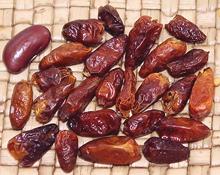
[(Yoruba - Nigeria)]
Ata Ijosi (pictured C. frutescence) is a very small Bird Pepper, hotness about H9. They are now very popular in Nigeria, fresh and dried, especially for Ata DinDin sauce. Ata Ijosi are up to 0.75 inch long and 0.32 inches wide, and are sometimes available on-line in North America.
Ata Wewe (C. frutescence) as best I can find, is Yoruba for Peri Peri Chilis, fresh and dried (H9). It seems to be more popular than Ata Ijosi, perhaps more available.
Ata Gungun, Ose (C. annuum) is the
Cayene chili, heat around
H8.
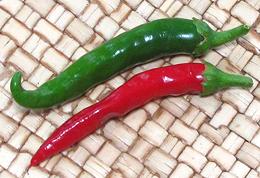 [Ose Nkiri (Nigeria); C. annuum]
[Ose Nkiri (Nigeria); C. annuum]
Originating in French Guiana, this famous chili has been used to make the
Cayenne chili powder used in many cuisines - except that powder is at
least as likely to be made from some other variety and just labeled
"Cayenne". Today there are many cultivars, but the Cayenne pod is
generally long and thin, up to nearly 10 inches, often curved at the tip,
and ripens pointing down. It is quite hot (
H8). Subst: Thai Chilis,
which are a Cayenne type cultivar.
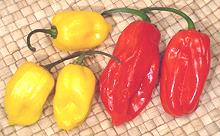 [Ose Oyibo, Atarodo, Ata Rodo (Nigeria); Pilipili Mbuzi (Tanzania, Congo);
C. chinense]
[Ose Oyibo, Atarodo, Ata Rodo (Nigeria); Pilipili Mbuzi (Tanzania, Congo);
C. chinense]
Originally from the Yucatán of Mexico, this extremely hot chili
(H10) is one of the most important
chilis in the Caribbean Islands and along the Caribbean coast of South
America. Due to the slave trade they were taken to West Africa along
with the nearly identical Scotch Bonnets. The two are now the dominant
chilis in the region. They come in Green, Red, Orange and Yellow, with
White, Purple and "Chocolate" varieties known. Shape can vary radically.
Those always available here in Southern California are the Habanero
Orange variety, which is more wrinkly than the photo specimens.The
name Habanero means "from Havana", but hot chilis have fallen out
of favor in Cuba.
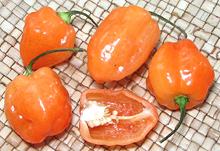 If you live in Southern California, this Orange Habanero is what you
will be using. It totally dominates the market here, and other varieties
are seldom seen. On the other hand, I haven't heard any complaints about
that. Every market serving a Latino community has a bin of them, and
Asian markets have at least foam trays of them. Appaerently they are
considered adequate for the job - high heat and good fruity flavor.
If you live in Southern California, this Orange Habanero is what you
will be using. It totally dominates the market here, and other varieties
are seldom seen. On the other hand, I haven't heard any complaints about
that. Every market serving a Latino community has a bin of them, and
Asian markets have at least foam trays of them. Appaerently they are
considered adequate for the job - high heat and good fruity flavor.
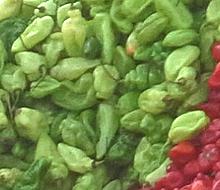 [Pettie Belle, Cheeky; C. chinense]
[Pettie Belle, Cheeky; C. chinense]
This chili is very popular in Ghana, Africa, usually used green, but
also sometimes red. They are quite wrinkled and often squat, very
much the shape of the Habanero Orange chilis we have here in Southern
California, but quite a bit smaller. They are also not nearly as hot
(H8), similar to Cayenne or Thai
Chilis. While one of the mildest Habaneros, they are described as having
a unique spicy and fragrant taste. They are not currently available in
North America. I have manged to get seeds (July 2022) and hope to have
chilis fairly soon.
Photo by SandisterTei distributed under license
Creative Commons
Attribution-ShareAlike v3.0 Unported.
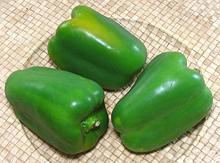 [Pilipili hoho (Tanzania); Capsicum annuum var grossum]
[Pilipili hoho (Tanzania); Capsicum annuum var grossum]
Basically these are medium size Bell Peppers, same as ours, and
are generally used green (H0).
Subst: None required, we have plenty of green bell
peppers in North America, and even some medium size ones.
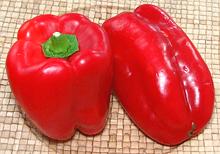 [Pilipili hoho (Tanzania); Capsicum annuum var grossum]
[Pilipili hoho (Tanzania); Capsicum annuum var grossum]
Many markets in Nigeria sell both squat and elongated Red Bell Peppers
as "Tatashe". No less an expert than Flo Madubike states firmly this is
not correct, and the two are not interchangeable in recipes. While
both are mild peppers, the Tatashe has thinner
walls and a flavor that is more intense and much more chili-like.
Our Red Anaheims would probably
be much closer than red bell peppers.
 [Bonnie Pepper, Scotty Pepper; Ose Oyibo, Atarodo (Nigeria);
Ball-of-fire (Guyana); Aji Chombo (Panama); C. chinense]
[Bonnie Pepper, Scotty Pepper; Ose Oyibo, Atarodo (Nigeria);
Ball-of-fire (Guyana); Aji Chombo (Panama); C. chinense]
This chili is often confused with the Habanero, but is a different
cultivar, though only in the Caribbean do people claim to be able to
tell the difference. It is the same hotness
(H10) as the Habanero, but with a
somewhat sweeter and smokier flavor. In appearance, it is very rumpled.
It got its name from a formerly common (now rare) variety in Jamaica that
was of a flattened disk shape said to look like a Scottish hat. Today,
due to the meddling of chili growers, they come in many shapes, colors
and levels of hotness. The largest in the photo was 2 inches long, 1.4
inches diameter, and weighed 5/8 ounce.
 [Capsicum annuum]
[Capsicum annuum]
Every market in Nigeria seems to have a different idea as to what a
Shombo Chili is, but all pretty much agree it's red and hot. The chili
that's shown most often is a long somewhat stout Cayenne type like those
in the photo to the left, sometimes even called Cayenne. Others show
long thin Cayenne peppers, and some show small pointed red chilis.
Chilis of this type and shape are not much available in North America,
so I suggest using the red chilis every ethnicity in Southern California
seems to feel is fine for their cuisine, the
Red Fresno Chili or the Thai Chili
depending on the hotness you want.
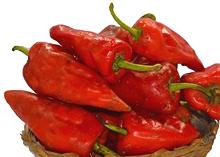 [Tatashe (Nigeria); Pilipili Hoho (Swahili); Romano Pepper; Red Bell
Pepper (common error); Capsicum annuum]
[Tatashe (Nigeria); Pilipili Hoho (Swahili); Romano Pepper; Red Bell
Pepper (common error); Capsicum annuum]
This is a large conical red pepper with low heat
(H1-H2?), growing
to 10 inches long. It is not available in North America, but our
Red Anaheim peppers may be
an acceptable substitute (perhaps a little hotter). In Nigeria it is
often called "Red Bell Pepper", but reliable sources say that is
definitely wrong and they are not interchangeable. The Tatashe, though
similarly mild, has thinner walls and a more intense and more chili-like
flavor. The confusion is so great some recipe writers, when they call
for "Tatashe" add "the long pointed one". Also see
Fresno Chili below.
Photo ©
LKA Cooperative in Nigeria, borrowed under Fair Use (non-commercial,
non-competitive, small, otherwise not available).
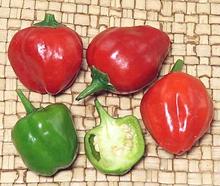 [Peppadew® Pepper, Malawi Piquanté, Sweet Piquanté Pepper;
Capsicum baccatum]
[Peppadew® Pepper, Malawi Piquanté, Sweet Piquanté Pepper;
Capsicum baccatum]
this is a small, roughly spherical, fairly thick walled chili with rather moderate heat (H3). It is grown commercially in Limpopo province of South Africa. It originated in South America, but was discovered in South Africa on a property formerly owned by a botanist. Actual flavor is very similar to Red Bell Pepper, but with heat. The largest in the photo was 1.45 inches long x 1.22 inches diameter.
This pepper is best known in it's pickled form, produced by
Peppadew International in South Africa and sold as Peppadew® Peppers.
Details and Cooking
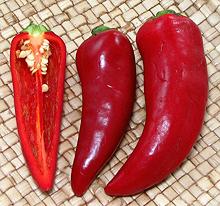 ["Red Jalapeno" (some U.S. supermarkets); C. annuum]
["Red Jalapeno" (some U.S. supermarkets); C. annuum]
Not an African Chili. This chili has been found just fine by pretty much
every ethnic community in Southern California. It is available in most ethnic
markets, particularly Korean, Southeast Asian, and Latin American. I have
seen it on European lists, so it is apparently invading there. It is quite
hot (H4-5), but, can be easily and
almost entirely disarmed by capping, splitting, and carefully removing
the seed mass and the internal membranes. Thus disarmed it should be
a fine substitute for the Tatashe Pepper (see above), though they are
smaller so you need to use more of them. For details
see our Fresno Chili page.
 [C. annuum]
[C. annuum]
Not an African Chili. This is our "go-to" Chili for wherever "hot green
chilis" are expected but not identified. Native to the mountains of Mexico,
these have more flavor than hot green chilis in most of the world, but within
reason. Serranos are fairly hot (about
H6), but the heat can be much reduced if necessary, by removing
the seed mass and membranes. They are usually used green with the seeds in.
They can be up to 4.5 inches (11.5 cm) long and 0.8 inch (2 cm) diameter.
The flesh is fairly thick, so they are not dried, though they are often
pickled.
 [Cuaresmenos (Mexico); C. annuum]
[Cuaresmenos (Mexico); C. annuum]
Not an African Chili, but nearly all recipes from Ethiopia, Eritrea
and Somalia I have seen written in English call for Jalapeños. This
Chili must satisfy the requirements of people who are "from there", so that's
what I use for that region. Fresh green, 2 to 3 inches by 1 inch diameter,
dark green with blunt tip, hotness
H5-H6. The skin is dark green (or red), smooth and shiny but often
has faint stretch marks (corking). Those with corking tend to be hotter. For
details see our Jalapño, Chipotle &
Morita Chilis page.
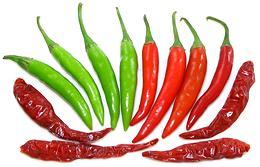 [Rat Turd Chili; Mak Pet Ki Nuu (Laos); Nga Yut Thee (Burma); Scuds
(some chefs); C. annuum]
[Rat Turd Chili; Mak Pet Ki Nuu (Laos); Nga Yut Thee (Burma); Scuds
(some chefs); C. annuum]
Not an African Chili. Thai Chilis are the chilis universally used as "small fresh chili", green or red, by all the ethnic communities here in Southern California. It is also displacing Bird Chilis in other parts of the world due to being easier to grow and harvest, so it's probably grown in Africa by now.
It is small, often less than 1-3/4 inches long as grown in Thailand,
but there are many varieties and those grown in California are often up
to 2-3/4 inches (more efficient to grow and harvest larger sizes). They
are narrow, pointy and start growing point up, but turn downward as they
reach full size. They turn from green to red when ripe (they may be
somewhat orange in between). They are very hot (
H8 to H9), slightly less hot when red ripe, and a little less than
that when dried. Fully red ripe prik ki nu dry very well. Those imported from
Thailand tend to be hotter than if you dried those grown in California.
Some minor varieties are black if in full sun, turning bright orange when
ripe.